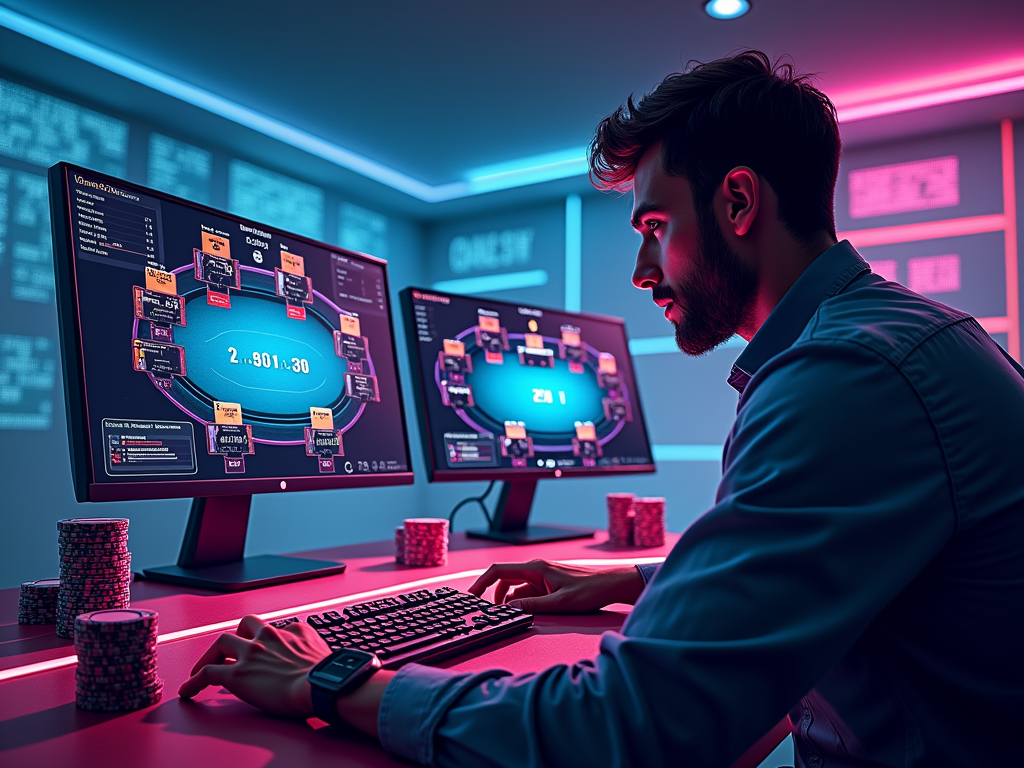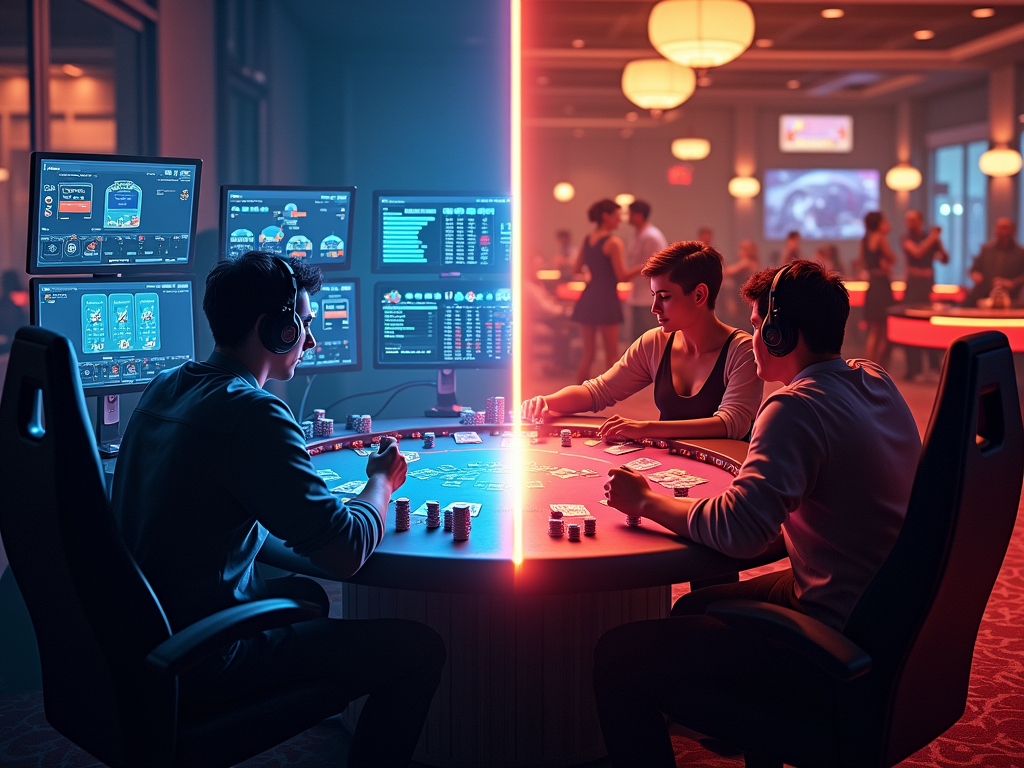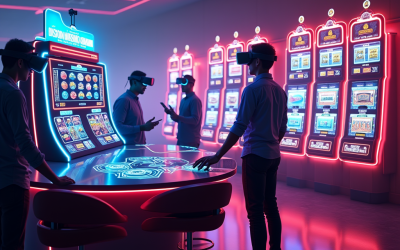Online Poker vs. Live Poker: Understanding the Differences
Online poker and live poker create distinct gaming experiences. Online play delivers quick action and advanced tracking tools, while live games emphasize face-to-face interaction and reading physical tells. The digital format enables players to join multiple tables at once, processing up to 280 hands per hour versus 20-30 hands in live settings.
Key Takeaways
- Online poker runs 3-4 times faster than live games, with automated features speeding up gameplay and allowing multi-tabling.
- Live poker games generate higher profits at lower stakes because recreational players and tourists frequent these venues.
- Physical tells dominate live games while online poker relies on digital data tracking, demanding different skills for success.
- Online poker has reduced rake and overhead costs, though live games can yield better earnings at higher stakes.
- Each format needs specific strategy adjustments – online play centers on GTO principles while live games reward exploitative tactics.
Online Poker: Speed and Precision
I notice online poker rewards technical precision and fast decision-making, backed by software tools that track patterns and tendencies. With the ability to multi-table and analyze stats in real-time, players must remain alert and efficient to maximize profit.
Live Poker: Psychology and Presence
Live poker demands stronger interpersonal awareness, reading opponents across the table while managing table dynamics. Observing an opponent’s behavior, timing, and physical gestures are key to understanding their hand strength and motives.
The Role of Game Pace in Strategy
The pace difference shapes strategy dramatically. Online players must process information rapidly across multiple screens, while live players can take time to observe their opponents’ habits and tells. This creates unique advantages in each format.
Profitability and Stakes
Stakes also affect profitability between formats. Live low-stakes games attract casual players looking for entertainment, creating softer competition. Online games feature tougher opponents but lower costs and more hands per hour, which can lead to a steadier grind in the long run.
Mastering Both Formats
Success in either format requires mastering its specific elements. Online pros excel at rapid mathematical decisions and multi-table management. Meanwhile, live pros read physical tells and leverage table psychology. Understanding these distinctions helps players choose their optimal environment or develop skills across both worlds.
The Fast-Paced World of Online Poker: A Numbers Game
Online poker moves at lightning speed compared to traditional casino games. I’ve found that online players typically see 60-100 hands per hour at a single table – a dramatic increase from the 20-30 hands you’d expect in a live setting. This accelerated pace creates an entirely different dynamic that reshapes how players approach the game.
Maximizing Hand Volume Through Multi-tabling
One of the biggest advantages of playing poker online is the ability to multi-table, letting you play multiple games simultaneously. By running four tables at once, you can process over 280 hands per hour – that’s nearly 10 times the volume of a live game. This increased exposure fast-tracks your learning curve and provides more opportunities to apply different strategies.
The rapid pace of online poker stems from several automated features that streamline gameplay:
- Instant dealing and shuffling eliminate manual dealer actions
- Automatic pot calculations and chip handling remove counting delays
- Built-in timers keep the action moving swiftly
- Preset bet sizing buttons speed up decision-making
- Quick fold options let you instantly move to the next hand
While this acceleration can supercharge your poker education, it also intensifies short-term variance. You’ll experience both winning and losing streaks more frequently than in live games. The speed also impacts your mental game – making quick, accurate decisions hand after hand requires intense focus and can lead to faster mental fatigue.
I recommend new players start with a single table to build comfort with the rapid pace. As your decision-making becomes more automatic, gradually add tables while monitoring your performance and mental stamina. Take regular breaks to stay sharp, and don’t hesitate to reduce tables if you feel your play quality declining.
The brisk tempo of online poker transforms the game into a numbers-driven experience where success often comes from maintaining consistent decision-making despite the accelerated pace. Master the speed, and you’ll unlock opportunities for both faster skill development and increased earning potential.

Why Live Games Are Often More Profitable
The Recreational Player Advantage
Live poker games at local casinos and card rooms tend to be notably softer than their online counterparts. I’ve found that brick-and-mortar venues attract a steady stream of recreational players, tourists, and casual gamblers who often view poker as entertainment rather than a serious money-making venture. These players typically haven’t studied advanced strategies or invested time in improving their game, creating more profitable opportunities for skilled players.
At a $1/$2 live table, you’ll frequently encounter business professionals unwinding after work, tourists trying their luck, and weekend warriors looking for some action.
Stakes Comparison and Skill Levels
The skill gap between online and live poker is particularly evident when comparing equivalent stakes. A winning strategy at $2/$5 live games might struggle to break even at $1/$2 online tables. Here’s what makes online games more challenging:
- Professional players can multi-table online, increasing their volume and presence across different games
- Online players have access to tracking software and detailed hand analysis tools
- The fast pace of online play leads to accelerated learning and improvement
- Geographic barriers don’t exist online, creating a global pool of skilled competitors
The convenience of playing poker from home has created a highly competitive online environment. I’ve noticed that skills needed to beat modest stakes online games ($1/$2) often translate to success at higher stakes live games ($2/$5 or $5/$10). This skill disparity means that competent players can often find more profitable opportunities in live games, despite the slower pace and higher overhead costs.
While online games offer advantages like increased hand volume and reduced travel expenses, live poker continues to provide better earning potential for many players, particularly at lower and mid-stakes levels. The social atmosphere and tourist-friendly environment of live venues create ideal conditions for skilled players to maximize their earnings.

Physical Tells vs. Digital Data: How to Read Your Opponents
Live poker and online poker require different skill sets when it comes to reading opponents. In live games, I focus on picking up physical tells that reveal information about hand strength and player confidence. Let me break this down into specific areas you need to master.
Reading Live Poker Tells
Physical tells can give away crucial information about your opponents’ hands. I’ve noticed that players often display unconscious behaviors when they’re holding strong or weak hands. Here are the key tells to watch for:
- Shaking hands while betting – often indicates excitement with a strong hand
- Staring intently at their chips – typically suggests they’re considering a big move
- Abnormal posture changes – sudden stiffening can signal bluffing
- Chip handling patterns – nervous shuffling might indicate uncertainty
- Changes in breathing patterns – rapid breathing can suggest stress or a big hand
Digital Tells and Data Analysis
In online poker games, I rely on digital tools and timing tells to understand my opponents. Heads-Up Displays (HUDs) have transformed how players gather information. These tools collect and analyze data from previous hands, creating detailed profiles of how opponents play.
The most valuable statistics I track include:
- VPIP (Voluntarily Put Money In Pot) – shows how often a player willingly enters pots
- PFR (Pre-Flop Raise) – indicates their pre-flop aggression levels
- Aggression Factor – measures their overall aggressive tendencies
- 3-Bet Percentage – reveals how often they re-raise pre-flop
Popular tracking software like PokerTracker 4 and Hold’em Manager 3 make collecting this data straightforward. However, timing tells also play a crucial role online. Quick actions often indicate pre-planned decisions, while unusual delays might suggest uncertainty or a tough decision.
I’ve found that keeping detailed notes on opponents helps track their tendencies across multiple sessions. This creates a more comprehensive picture of their playing style, helping me make better decisions in future encounters. By combining these digital insights with careful observation of betting patterns and timing tells, I can build accurate profiles of my opponents’ strategies and tendencies.
Remember that while physical tells in live games can be misleading, digital data provides concrete evidence of playing patterns. Your success at either format depends on your ability to gather and interpret the right information for that environment.
The Real Cost of Playing Poker
Understanding Rake Differences
I’ve found that one of the biggest financial hurdles in poker comes from rake – the fee that poker rooms charge for hosting games. Online poker platforms generally take a 5% cut from each pot, with caps ranging from $3 to $5 per hand. This stands in stark contrast to brick-and-mortar casinos, where the rake typically hits 10% of the pot with higher caps between $5 and $7. Don’t forget about those dealer tips in live games – they’ll cost you an extra $1–$2 per pot you win.
Hidden Expenses in Live Play
Live poker brings several additional costs that can eat into your bankroll. Here’s what you need to account for when playing in person:
- Transportation costs and parking fees
- Food and beverages at casino prices
- Hotel accommodations for out-of-town games
- Time spent traveling to and from venues
- Appropriate attire for casino environments
These expenses can add up quickly, making online poker more cost-effective for regular players. For instance, if you’re playing micro-stakes games, the lower online rake structure combined with zero additional expenses means you’ll keep more of your winnings. The math becomes particularly important at lower stakes, where rake can represent a significant portion of your potential profits.
I’ve noticed that many players overlook these cumulative costs when comparing online and live play. A session that appears profitable on paper might actually be running at a loss once you factor in all the peripheral expenses. The choice between online and live poker often comes down to your playing frequency and stake levels – high-volume players at lower stakes typically find better value in online games, while higher-stakes players might find the live environment more profitable despite the extra costs.
Winning Strategies for Both Formats
The fundamental strategies between online and live poker require distinct adjustments to maximize your winning potential. I’ve found that successful online players tend to stick closer to Game Theory Optimal (GTO) strategies, as they’re typically facing more skilled opponents who’ve studied the mathematical foundations of the game.
Format-Specific Tactics
Pre-flop bet sizing is a critical area where you’ll need to adapt between formats. In online games, I recommend keeping your raises between 2.2x to 3x the big blind to maintain pot control and minimize variance. However, in live settings, you’ll want to bump those raises up to 4x to 6x the big blind — sometimes even higher if the table dynamics allow it.
Here are the key strategic adjustments you should make when switching between formats:
- Online Play Focus:
- Stick to consistent bet sizing
- Maintain balanced ranges
- Use multiple bet sizes for different board textures
- Keep detailed notes on opponents
- Multi-table to increase hourly rate
- Live Play Adjustments:
- Look for physical tells
- Engage in table talk to gather information
- Adjust to larger bet sizing
- Target recreational players
- Focus on exploitative strategies
When playing online, I’ve noticed that bluffing frequencies need to be more carefully balanced since opponents can track your statistics through HUD software. In contrast, mastering live poker games often allows for more straightforward value betting against weaker opposition who may call too liberally.
The speed of online play demands quick decision-making and solid fundamentals. You’ll need to process information rapidly and make decisions based on betting patterns and position rather than physical tells. Live poker gives you the luxury of time to observe your opponents and pick up on their tendencies, making exploitative play more profitable.
I recommend practicing both styles to become a well-rounded player. The skills you develop online — like quick math calculations and playing multiple streets ahead — will improve your live game. Similarly, the patience and observational skills you learn from live play will enhance your ability to spot patterns in online games.
Remember to adjust your aggression levels appropriately for each format. Online players typically show more aggression with lighter holdings, while live players might need to tighten up their ranges due to larger bet sizes and more calling stations. Success in either format comes down to understanding these nuances and adapting your strategy accordingly.
The Tools That Drive Success
Online poker offers a distinct advantage with powerful digital tools that aren’t available in live settings. I’ve found that Heads-Up Displays (HUDs) transform how players process information by providing real-time stats on opponents’ tendencies, making strategic decisions faster and more precise.
Digital Advantages in Online Play
The modern online player’s toolkit has become increasingly sophisticated. Here are the essential tools that create a competitive edge:
- HUD software tracks vital statistics like VPIP (Voluntarily Put Money in Pot) and PFR (Pre-Flop Raise) percentages, allowing for quick adjustments against opponents
- Equity calculators provide instant odds calculations during crucial decision points
- Hand tracking software stores playing history, enabling detailed post-session analysis
- Advanced poker training programs and solvers like PioSOLVER help perfect Game Theory Optimal (GTO) strategies
In contrast, live poker demands a different skill set. Since electronic devices aren’t permitted at the table, I rely heavily on mental math and observational skills. Success in live environments depends on:
- Reading physical tells and betting patterns
- Mental note-taking of player tendencies
- Quick mental probability calculations
- Pattern recognition in bet sizing
- Memory retention of previous hands and situations
The absence of digital tools in live poker creates a more psychological game where interpersonal skills matter significantly. I focus on developing strong memory techniques and emotional control to compensate for the lack of technological assistance.
This stark contrast between online and live environments means successful players must adapt their strategies accordingly. While online players can leverage data-driven decisions, live players must sharpen their instincts and observational abilities to achieve similar results.
Sources:
PokerNews: Online Poker vs Live Poker: The Biggest Differences
Upswing Poker: 10 Key Differences Between Live and Online Poker Strategy
CardPlayer Magazine: Transitioning Your Game: Online Poker vs. Live Poker





